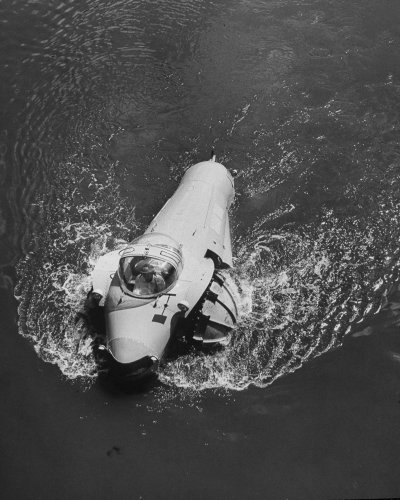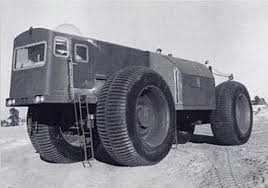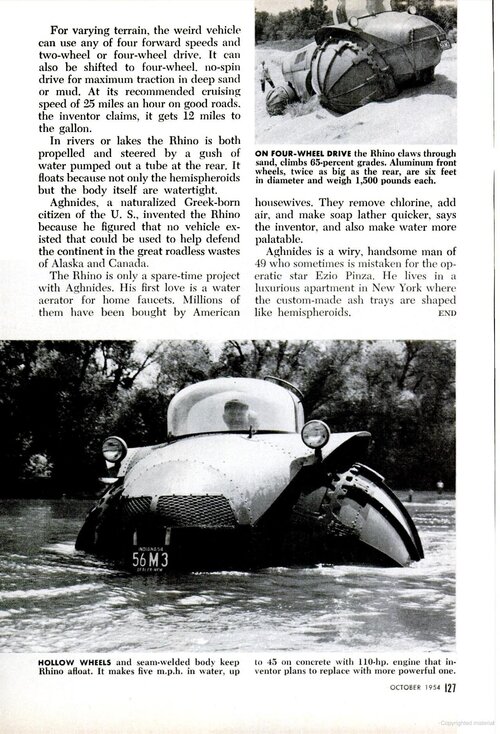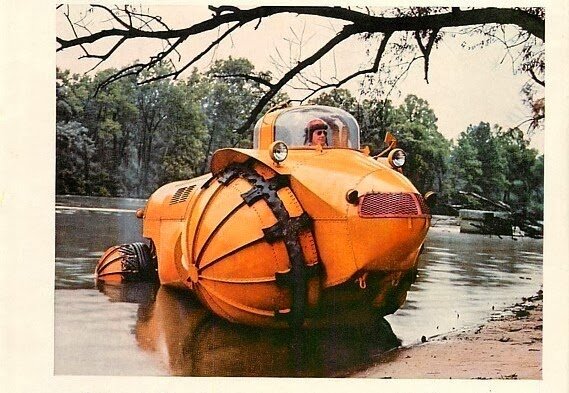seruriermarshal
ACCESS: Top Secret
- Joined
- 4 May 2008
- Messages
- 1,180
- Reaction score
- 557
Greek-American inventor Elie Aghnides amassed a fortune coming up with clever inventions.
One of his more unusual creations was the "Rhino," an amphibious four-wheeled vehicle designed to patrol and defend the vast roadless wastes of Alaska and Canada.
Weighing in at five tons, the four-wheel-drive machine could hit speeds of 45 miles per hour on the highway.
Defining features were its massive front wheels, which had six-foot diameters and weighed 1,500 pounds each. Their hollow, hemispherical shape gave the Rhino its unique all-terrain capability. As the vehicle sank into mud, sand, or other soft surfaces, the bearing surface of the ribbed wheels increased, giving it greater traction.
The Rhino's massive wheels and low center of gravity also meant it could tip 75 degrees to either side without toppling over.
In the water, the hollow wheels provided flotation, while a rear water jet provided propulsion at speeds of about four miles per hour.
The Marmon-Herrington Company of Indianapolis built one prototype of the Rhino for demonstration. The United States military declined to purchase any, reportedly out of concern that the wheels could be punctured by gunfire, sinking the vehicle.
http://mashable.com/2015/09/17/the-rhino-vehicle/#RqYBBJm.akqN
One of his more unusual creations was the "Rhino," an amphibious four-wheeled vehicle designed to patrol and defend the vast roadless wastes of Alaska and Canada.
Weighing in at five tons, the four-wheel-drive machine could hit speeds of 45 miles per hour on the highway.
Defining features were its massive front wheels, which had six-foot diameters and weighed 1,500 pounds each. Their hollow, hemispherical shape gave the Rhino its unique all-terrain capability. As the vehicle sank into mud, sand, or other soft surfaces, the bearing surface of the ribbed wheels increased, giving it greater traction.
The Rhino's massive wheels and low center of gravity also meant it could tip 75 degrees to either side without toppling over.
In the water, the hollow wheels provided flotation, while a rear water jet provided propulsion at speeds of about four miles per hour.
The Marmon-Herrington Company of Indianapolis built one prototype of the Rhino for demonstration. The United States military declined to purchase any, reportedly out of concern that the wheels could be punctured by gunfire, sinking the vehicle.
http://mashable.com/2015/09/17/the-rhino-vehicle/#RqYBBJm.akqN








